Dick Tracy
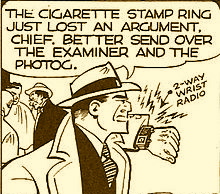
Dick Tracy (1945)
The movie “Dick Tracy” (also known as “Dick Tracy, Detective”) is a 1945 American pulp action film based on the Dick Tracy comic strip created by Chester Gould. The film is the first installment of the Dick Tracy film series. Dick Tracy (Morgan Conway), a supremely intelligent police detective, must solve a series of brutal murders in which the victims, all from different social and economic backgrounds, are viciously slashed to pieces by the one known as Splitface. Suspects flourish but Tracy must find the common link of extortion and revenge before more are killed. Directed by William A. Berke, produced by Herman Schlom, written by Eric Taylor and Chester Gould (comic), starring Morgan Conway as Dick Tracy (the tough detective, who let’s nothing stand in the way of justice), Anne Jeffreys as Tess Trueheart (Tracy’s girlfriend, who often falls victim to her boyfriends workoholism), Mike Mazurki as Alexis “Splitface” Banning (a psychotic ex-con who seeks revenge. His weapon is a sharp surgical knife. He has a big disfiguring scar across his face), Jane Greer as Jane Owens (a suspect), Lyle Latell as Pat Patton (Tracy’s bumbling assistant), Joseph Crehan as Chief Brandon (the reliable chief of police), Mickey Kuhn as Junior (Tracy’s adopted son), Trevor Bardette as Prof. Linwood J. Starling (a strange medium, and also a suspect), Morgan Wallace as Steve Owens (a stern businessman), Milton Parsons as Deathridge the Undertaker (a mysterious, skeletal suspect) and William Halligan as Mayor (the worried mayor of Chicago).
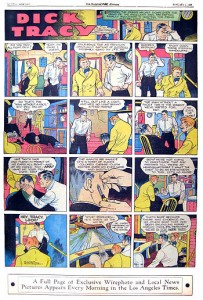 Chester Gould’s Dick Tracy vs. “The Blank” (January 2, 1938)
Chester Gould’s Dick Tracy vs. “The Blank” (January 2, 1938)
Dick Tracy is a comic strip featuring Dick Tracy (originally Plainclothes Tracy), a hard-hitting, fast-shooting and intelligent police detective. Created by Chester Gould, the strip made its debut on October 4, 1931, in the Detroit Mirror. It was distributed by the Chicago Tribune New York News Syndicate. Gould wrote and drew the strip until 1977.
Comic strip – Characters and story
The strip’s villains are arguably the strongest appeal of the story. Tracy’s world is decidedly black and white. The bad guys are sometimes so evil that their very flesh is deformed to announce their sins to the world. The evil sometimes is raw and coarse, like the criminally insane Selbert Depool (“looped” spelled backwards—typical Gould). At other times, it is suave, like the arrogant Shoulders, who cannot help thinking that all women like him. It can even border on genius, like the Nazi spy Pruneface, a machine design engineer who dabbles with a chemical nerve gas. Chester Gould introduced a raw violence to comic strips, reflecting the violence of 1930s Chicago. Gould did his best to keep up with the latest in crime fighting techniques; while Tracy often ends a case in a shootout, he uses forensic science, advanced gadgetry, and wits to track the bad guy down. The strip was an early example of the police procedural mystery story. Actual “whodunit” plots were relatively rare in the stories; the focus is the chase, with a criminal committing a crime and Tracy solving the case during a relentless pursuit of the criminal, who becomes increasingly desperate as the detective closes in.
Gould’s most popular villain was Flattop Jones, a freelance hitman with a large head as flat as an aircraft carrier‘s flight deck. Flattop was hired by black marketeers to murder Tracy, and he nearly accomplished that before deciding to first blackmail his employers for more money. This proved to be a fatal mistake, since it gave Tracy time to signal for help. He eventually defeated his assassin in a spectacular fight scene even as the police were storming the hideout, but Flattop himself escaped. When Flattop was eventually killed, fans went into public mourning, and The Flattop Story was reprinted in its entirety in DC’s series of Oversize Comic Reprints in the 1970’s.
Reflecting some of the era that also produced film noir, Gould tapped into the existential despair of the criminals as small crimes led to bigger ones. Plans slipped out of control and events sometimes happened for no apparent reason, portraying their lives as unpredictable and cruel. Treachery was everywhere as henchmen were ruthlessly killed by their bosses, who were in turn betrayed by jilted girlfriends. “Good people” in the wrong place at the wrong time were gunned down.
Amid these cases, the strip had considerable character storylines in the series. Tracy had a difficult relationship with his girlfriend, Tess Trueheart, who found her beau’s firm dedication to his work both an irritating interference and a physical danger with her being often caught in the crossfire in his cases. The stormy relationship hit its nadir when she rejected Tracy to marry a charming wealthy ex-baseball player, only to find herself trapped in a deadly family intrigue that led to murder and the suicide of her husband that proved so traumatizing that she resumed her relationship with Tracy with a much more patient attitude toward his commitments.
Tracy had his own concerns with a young homeless boy whom he took under his wing to become adopted son and sidekick with the name, Dick Tracy Jr., or simply “Junior.” The boy would often participate in investigations at great personal risk until eventually finding his own career as a police forensic artist at the service of his father’s precinct. Tracy had a professional partner, the ex-steel worker Pat Patton. Joining the force, Pat had little confidence in his own abilities to the point of seriously considering leaving the force. However, he gradually grew into his career until he became a detective of considerable skill and courage—enough to satisfy Tracy’s needs.
Evolution of the strip
On January 13, 1946, Gould changed Dick Tracy forever with the introduction of the 2-Way Wrist Radio, having drawn inspiration from a visit to inventor Al Gross. This seminal and fictional communications device, worn as a wristwatch by Tracy and members of the police force, became one of the strip’s most immediately recognizable icons, and can be thought of as an inspiration for later technological developments, such as cellular phones and later watch phones. The 2-Way Wrist Radio was upgraded to a 2-Way Wrist TV in 1964. This development also led to the introduction of an important supporting character, Diet Smith, an eccentric industrialist who financed the development of this equipment. In a conspicuous coincidence, the idea of a radio built into a wrist watch played an important role in the story line of “Superman – The Talking Cat” broadcast on the Mutual Broadcasting System on January 9 through 28, 1946 (episodes 878 through 891).
Towards the end of the 1940’s, Gould took steps to shake up the status quo of his strip. In late 1948, for instance, a botched security detail led to the death of the semi-regular character Brilliant, the blind inventor of the 2-Way Wrist Radio (among other devices) and son of industrialist Diet Smith. Chief Brandon, Dick Tracy’s superior on the police force and a presence in the strip since 1931, voluntarily resigned in shame. Pat Patton, heretofore Tracy’s rather buffoonish partner, was promoted to police chief in Brandon’s place. Gould later explained this seemingly improbable turn of events by stating that, within the strip’s reality, Tracy was offered the job first but had declined, personally recommending Patton instead. To take Patton’s place as Tracy’s sidekick, a new character, Sam Catchem (based on Gould’s old friend, Al Lowenthal), was introduced.
The 1950’s
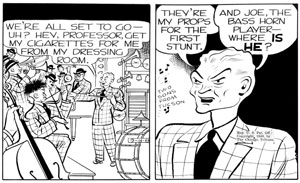 In 1949, Spike Jones was caricatured in the Dick Tracydailies as Spike Dyke.
In 1949, Spike Jones was caricatured in the Dick Tracydailies as Spike Dyke.
Christmas Day 1949, after a rocky courtship that lasted 18-years of the strip’s history, Dick Tracy and Tess Trueheart finally married. Gould changed Tracy with the times, sometimes with mixed results. He introduced topical story lines about television, juvenile delinquency, graft, organized crime, and other developments in American life during the 1950’s. Elements of soap opera began to permeate the strip with Dick, Tess, and Junior (along with the Tracys’ new baby daughter, Bonnie Braids), at home as a family. Depictions of family life alternated, and intertwined, with the shadowy crime drama that was always the strip’s mainstay, such as the kidnapping of Bonnie Braids by fugitive Crewy Lou, or Junior’s girlfriend, Model, being accidentally shot and killed by her brother, a wanted murderer of a police officer.
Gould incurred some controversy when he had Tracy, on a police officer’s salary, live in an unaccountably ostentatious manner in a large home complete with a personal Cadillac. Gould responded with a story where Tracy was accused of corruption and had to explain the origin of his possessions in detail, such as stating he used personal savings he frugally accrued for his house while the Cadillac was a prototype he was test running for Diet Smith. In his book-length examination of the strip, Dick Tracy – The Official Biography, Jay Maeder suggested that Gould’s critics were largely unsatisfied by his explanation. Nevertheless, the controversy eventually faded, and the cartoonist reduced exposure to Tracy’s home life.
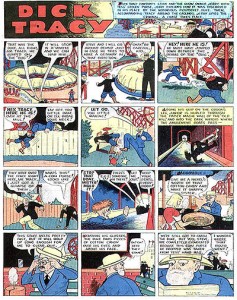 Chester Gould’s Dick Tracy vs “The Mole” (October 12, 1941)
Chester Gould’s Dick Tracy vs “The Mole” (October 12, 1941)
With the exception of The Big Boy, the strip’s first villain, a fictionalized version of Al Capone, and a few others, Tracy’s cases tended to involve independent operators rather than organized crime figures. In the 1950’s, with growing public awareness of organized crime growing, due to events like the Kefauver Hearings, Tracy began to take on a series of big-time mobsters such as the King, George “Mr. Crime” Alpha, Odds Zonn and Willie “The Fifth” Millyun.
As Tess faded into the background as a major character, the changing face of law enforcement in real life was also reflected in Tracy’s taking on a female assistant, rookie policewoman Lizz Worthington, who joined the police force in 1956 and immediately was assigned to help in the investigation of her long-lost sister’s murder by juvenile delinquent Joe Period. Later in that same sequence, Period partnered with Flattop’s son, Flattop Jr.
Space period
As technology progressed, so too did the methods Tracy and the police used to track and capture criminals. These took the form of increasingly fanciful atomic-powered gadgets and devices developed by Diet Smith Industries. This eventually led to the 1960s advent of the Space Coupe, a spacecraft with a magnetic propulsion system. This marked the beginning of the strip’s “Space Period,” which saw Tracy and friends having adventures on the Moon and meeting Moon Maid, the daughter of the leader of a race of humanoid people living in “Moon Valley” in 1964. After an eventual sharing of technological information, Moon technology became standard issue on Tracy’s police force, including air cars, flying cylindrical vehicles. The villains became even more exaggerated in power, resulting in an escalating series of stories that no longer resembled the urban crime drama roots of the strip. During this period, Tracy met famed cartoonist Chet Jade, creator of the comic strip Sawdust, in which the only characters are talking dots.
One of the new characters, Mr. Intro, was only manifest as a disembodied voice. His goal was world domination in the vein of a James Bond villain. Tracy eventually used an atomic laser beam to annihilate Intro and his island base.
Junior married Moon Maid in October 1964. Their daughter, Honey Moon Tracy, had antennae and magnetic hands. In the spring of 1969, Tracy was offered the post of Chief of Police in Moon Valley. However, Tracy ended up back on Earth when the Apollo 11mission in 1969 showed that the moon was barren of all life. Many of the accouterments of the space period stories, such as the Space Coupe and much of the high-tech gadgetry, remained for many years afterward. Moon Maid receded from the storyline.
The stories of this period took an increasingly condemnatory tone pertaining to contemporary court decisions concerning the rights of the accused, which often involved Tracy being frustrated by legal technicalities. For example, having caught a gang of diamond thieves red-handed, Tracy was forced to let them walk because he could not prove, beyond reasonable doubt, that the diamonds were stolen. As he saw the thieves get off without penalty, Tracy was heard to grumble, “Yes, under today’s interpretation of the laws, it seems it’s the police who are handcuffed!”
1970’s
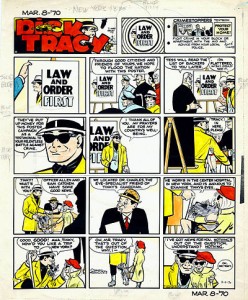 Color guide for Dick Tracy (March 8, 1970)
Color guide for Dick Tracy (March 8, 1970)
In the 1970’s, Gould modernized Tracy by giving him a longer hair style and mustache, and added a hippiesidekick, Groovy Grove. Groovy’s first appearance in print, as it happened, occurred during the same week as the Kent State shootings. Groovy remained with the strip, off and on until his death in 1984.
Shortly before his retirement, Gould drew a strip in which Sam, Lizz, and Groovy held Tracy down to shave off his mustache.
At this time, the standard publication size and space of newspaper comics was sharply reduced; for example, theDick Tracy Sunday strip, which had traditionally been a full-page episode containing 12 panels, was cut in size to a half-page format that offered, at most, eight panels—these new restrictions created challenges for all comic artists.
In one of Max Allan Collins‘ first stories as the strip’s writer, the gangster known as “Big Boy,” whose gang members had killed Tess Trueheart’s father years ago, learned that he was dying and had less than a year to live. Big Boy, still seeking revenge on the plainclothesman who sent him up the river, wanted to live just long enough to see Tracy’s death. He put out an open contract on Tracy’s head worth one million dollars, knowing that every small-time hood in the City would take a crack at the famous cop for that amount of money. One of the would-be collectors rigged Tracy’s car to explode, but inadvertently killed Moon Maid instead of Tracy in the explosion. A funeral strip for Moon Maid explicitly stated that this officially severed all ties between Earth and the Moon in the strip, thus eliminating the last remnants of the Space Period. Honey Moon received a new hairstyle that covered her antennae, and was ultimately phased out of the strip. Junior later married Sparkle Plenty (the daughter of B.O. and Gravel Gertie Plenty), and had a daughter named Sparkle Plenty Jr. In the 1990’s, Tracy’s own son, Joseph Flintheart Tracy, took on a role similar to Junior’s in the earlier strips. During the late 1970s the strip was thought to have been drawn by a few other artists due to an ailing Gould.
Plenty family
The Plenty family was a group of goofy redneck yokels headed by the former villain, Bob Oscar (“B.O.”), along with Gertrude (“Gravel Gertie”) Plenty. Gravel Gertie was introduced as the unwitting dupe (accessory) of the villain, The Brow, who was on the run from Dick Tracy. The family provided a humorous counterpoint to Tracy’s adventures. The Plenty sub-story was decades long, and saw Sparkle Plenty grow from an infant to a young married lady, eventually becoming a beautiful fashion model. Sparkle Plenty’s May 30, 1947, birth became a significant mainstream media event, with spinoff merchandising and magazine coverage.
The Plenty family appeared with Tracy in a story that occurred in a bank, where “B.O.” found a way to prevent thieves from snatching an envelope of money from a counter.
In the April 24, 2011 strip, B.O. and Gertie had a second child, Attitude, a boy who is as ugly as Sparkle is beautiful. His face has yet to be shown.


